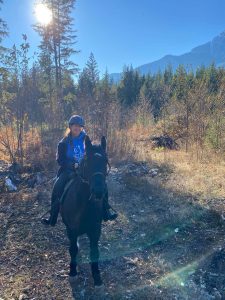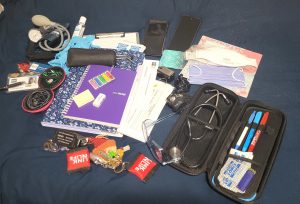“While the spoken word can travel faster, you can’t take it home in your hand. Only the written word can be absorbed wholly at the convenience of the reader.” – Kingman Brewster, Jr.
Hello!
I’m Deborah. This is my eighth course in the MET program. I live in Squamish, British Columbia with my 21 year old daughter, a little old dog and young tabby cat. On the weekends, I volunteer at a horse rescue in Squamish and lease one of the horses there. I ride him almost every weekend (except in the winter). I have been an RN for over 30 years and currently have been teaching in the nursing program at a polytechnic in Burnaby, British Columbia for 8 years.
For this task, I chose my nursing bag. I carry this bag every day at work. I teach in a nursing program in the third year of a three year accelerated program in a home care nursing context. I have a group of eight clinical students at a home health unit in Vancouver, BC. I bring this bag to the health unit and with me when the students visit clients at their homes with either wounds or for chronic disease management.
In my bag is:
- My BCIT employee ID card and swipe card for the unit on a chain lanyard.
- My BCIT RN name tag
- Sets of ear buds for Zoom calls and presentations
- An accordion file folder containing:
– student weekly schedule
– assignment guidelines
– weekly module/lesson plan
– home care nursing resources/forms
- My notebook for recording items to discuss during huddles and post clinical conferences
- Tape flags & sticky notes
- Plastic case for surgical masks and N95 masks (PPE)
- My goggles (PPE “Stoggles”)
- My stethoscope case with pens, Frixion eraser, alcohol swabs and gloves
- My reading glasses
- A pad
- Sphygmomanometer (BP cuff)
- An oximeter (device using light beam to read the level of oxygen contained in red blood cells)
- A clipboard
- Extra alcohol swabs
- My work phone
- My personal phone
- My house keys (has a pocket CPR mask on it)
- My car keys (also has a pocket CPR mask on it)
- A headlamp
- Gloves
- Hand sanitizer
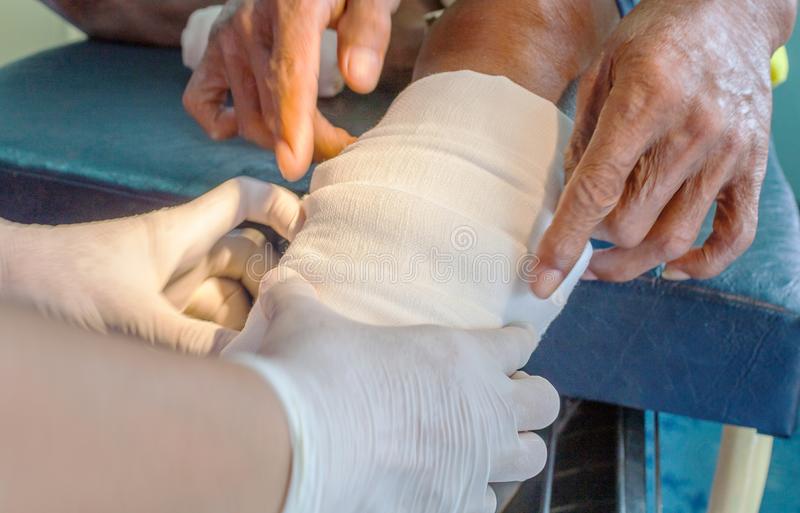
I use most of these items in my day at work with the students. I use my PPE’s on every visit with my students. I use the clipboard to store the client information (address, etc.) and then write notes on the student’s performance on the visit to enter into the clinical evaluation at mid-term and final. My reading glasses I use daily as well. The stethoscope, BP cuff and oximeter are used more rarely, but knowing I have them in case they are needed is comforting and the unit doesn’t provide these. The headlamp I use for almost every wound care visit as some client’s homes don’t have enough light to see. My work phone I use throughout the day to not only connect with my students (“I’m on my way”; “meet in front of the client’s apartment building”; “our meeting is in room 227”; etc.), but also to keep up with the other clinical faculty during the day – we often have new faculty members who have questions that come up during the clinical day with their students. I use my personal phone every day, of course – paying for parking in Vancouver, for example.
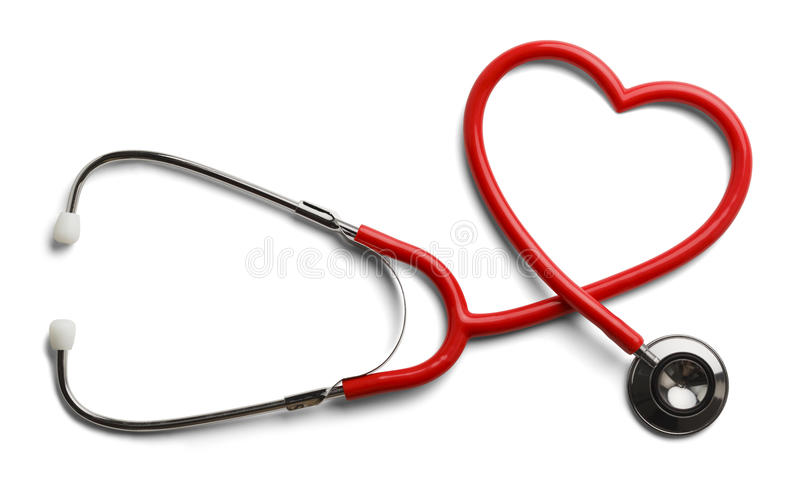
In terms of texts, they are more similar to the older interpretations of the concept, such as tektōn (craftsman), as I carry my ‘tools of the trade’. Nursing is often called an ‘art and a science’ and tends to sit in either Humanities or Health Sciences as opposed to Medicine. The stethoscope is an iconic symbol of the (Western) medical profession and is a tool that almost every nurse uses in the course of their work. It is a tool that skilled artisans (nurses, in this case) use to create their treatises. Using numbers and other data, we translate these symbols (numbers and words) into meaning that health care professionals can understand and communicate to each other. This communication takes the form of verbal, written, and electronic information that is transmitted within the medical and health care community. The other parallel is in the word technē referring to, in this case, a skill or skills – not only in teaching the art of nursing but also performing the skills required for the nursing profession. The other items, such as the notebook demonstrate less of a reliance on phones or laptops as alot of what I do offers no opportunities for use of these things during student home visits – I am either holding a light for the student doing wound care or demonstrating the application technique for something like compression stockings. So I am not able to use my phone or tablet during these visits, and have to jot down notes afterwards – usually while sitting in my car before going to the next visit. I have thought about using a speech to text app, but can’t find one that works for me, and it’s easier for me to scribble notes on a page rather than trying to view tiny text on a phone screen – my age showing there :).
Some of the text technologies in my bag are obvious, like my pen and papers and phones. I like using the Frixion pens because they are erasable ink. This may show that I am not always confident in what I write down and am often erasing and changing things. Some are not so obvious, such as the BP cuff. While the cuff gives you numbers, you still record them somehow either by writing them down or printing out a reading from the machine, and from them, interpret what they mean. The same applies to the pulse oximeter. The machine records something that’s happening internally, as in this case, the amount of oxygen present in the red blood cells, and provides a number that is recorded and must be interpreted. These indicate that language and communication is through scientific and imperial evidence.
I think, in this case, the papers and notebook provide clues to my prose literacy – the ability to read and write at not only a basic level, but also at an advanced level, along with jargon from both educational and health professional lenses. The other items speak to what we call health literacy – the ability to ‘access, comprehend, evaluate and communicate information as a way to promote, improve and maintain health in a variety of settings across the life course’ (Public Health Agency of Canada, n.d.). I could probably get a tablet and stylus that I can write my notes in and carry with me, but I haven’t yet done that. I also worry about privacy when recording client or student information in a device. The paper I can shred without it going to another country via the internet.
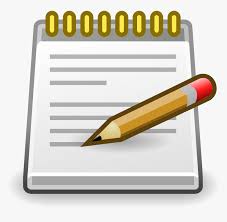
I struggle a lot with anxiety and imposter syndrome, which (I don’t think) shows in my outward appearance. The feedback I have received from students is one of calmness and a huge wealth of experience and knowledge. Inwardly, though, I don’t feel that. The notes in my notebook guide me to remember points to speak about as my social anxiety often prevents me from remembering things. I carry my PowerPoint notes pages for our weekly clinical conferences, and these are often in script format to cover my anxiety. I don’t really need such prescriptive texts, but I feel more secure when I have everything written out and have an idea of what I’m going to say beforehand. A Toastmaster, I am not.
I’ve been an RN for a very long time. 15 or 25 years ago, I was working in acute care hospitals. While I didn’t carry a bag, I did carry a lot of items around with me in a belt bag/fanny bag. I would have bandage scissors, tape, gloves, penlight, pen/pencils, piece of paper for writing down vital signs and other assessment information on my patients, my stethoscope, alcohol swabs, clamps for IV’s – why do you think nursing scrubs have so many pockets? Now, I have all these things in my bag, plus items that I don’t have handily available like BP cuffs and oximeters, as well as items for teaching clinical, which I wasn’t doing previously.
I’m not sure whether archeologists would see educator (unless my name tag was included), but they would definitely see items from a medical profession. They may think I’m a traveling medical professional, if the BP cuff and stethoscope and other equipment are recognizable to them. If the papers had survived the time capsule, they may indicate someone who had to coordinate people, and maybe evaluate their thinking or performance. In terms of engagement with text technologies, there are several cues that indicate the person used equipment/technology to interpret data for them and was immersed in digital technology. Things like the gloves and light may also indicate that there were some elements that were hands-on and dependant more on other types of interpretive or cognitive skills rather than actual text technologies.
Reference
Public Health Agency of Canada. (n.d.). Public Health Agency of Canada – Canada.ca. https://www.canada.ca/en/public-health.html?utm_source=VanityURL

